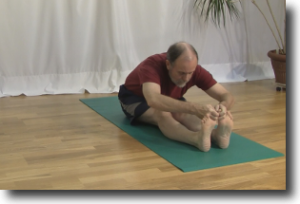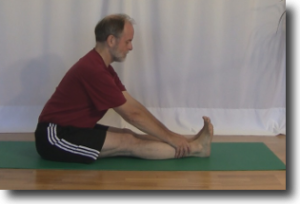“The last time I tried Paschimottanasana I pulled my hamstrings and it took a couple of weeks for them to heal.” thought Alice “I hope this new technique works.”
Alice inhales and lifts her torso slightly. Exhaling she lowers her torso again. With each breath she takes Alice is moving away from and towards her Edge.
Her teacher told her that working with her Edge is the best way to improve her flexibility and avoid injuring her hamstrings again.
Before we get into what your Edge is and how to use it to improve your flexibility, let’s have a look at Paschimottanasana.
What is Paschimottanasana
Paschimottanasana is a seated forward fold that occurs at the beginning of the Ashtanga Yoga primary series.
Paschimottanasana (pronounced POSH-ee-moh-tan-AHS-anna) is the Sanskrit name of the pose. Paschimottana means intense stretch of the west and Uttana means intense stretch. The literal translation of the name is Intense stretch of the west. It is usually called simple forward fold in English.
When you perform Paschimottanasana you are stretching your spine, shoulders and hamstrings as well as soothing headaches, reducing anxiety and fatigue.
Paschimottanasana is straight forward pose to do since there is no twisting or binding involved.
How to do Paschimottanasana
You start in Dandasana sitting on the floor with your legs together and straight out in front of you.
From here you lift your ribs slightly, tip your hips forward bringing your torso down toward your legs.
Now reach your hands towards your feet and bring your gaze towards your toes.
Hold here for several breaths.
In this pose you are going to find your Edge in your hamstrings as you bring your hips and torso forward and down towards your legs.
What is your edge
Your Edge is that challenging yet comfortable place where you are applying the maximum safe amount of stretching tension to your muscles without causing them injury.
Your Edge in combination with your Ujjayi breath will improve your flexibility and protect your from injury.
You can stay away from this edge, in which case nothing will happen. You will be in a very safe place but no stretching of your muscles will happen and you will not increase your flexibility.
You can go beyond your edge and challenge your muscles to lengthen quickly. This is a very dangerous place to be. In the short term you may increase your flexibility but you are at great risk of injuring your muscles and interrupting your practice while you recover from your injury.
Staying away from your edge is a comfortable place and you feel like you can stay there forever. Going beyond your edge is an uncomfortable place to be and you can’t wait for the stretch to be over so you can get out of there. There is a third option and that is to stay at your edge.
The best place is this third option: staying at your edge. This is the place in your stretch that you find challenging but you feel safe. While it is a challenging place to be you feel like you can stay there for a long time.
Once you find your Edge it is time to start working with it to improve your flexibility.
How to work with your edge
As you fold forward you will discover that your hamstrings are short and prevent you from bringing your torso all the way down towards your legs. Adjust the stretching sensation in your hamstrings until you find that comfortable and challenging place which is your edge.
Now that you have found your edge you use your breath to work with your edge and improve your flexibility.
First inhale and let your torso rise up slightly. With this movement you back away from your edge and reduce the tension on your hamstrings.
Next exhale and let your torso move forward slightly. This small movement forward will increase the tension on your hamstrings.
Surprisingly this slight movement away from a towards your edge co-ordinated with your slow breathing will help to move you further into the pose.
How does breathing help your edge move
Moving back from your edge when you inhale lets your muscles relax slightly.
Moving forward slowly with your exhale returns the stretching tension to your hamstrings.
When you stop the stretch and stay just short of your Edge in that comfortable and challenging place your muscles start to relax.
As your muscles relax your Edge will move a small amount and you will be able to move a little bit further into your forward fold.
Summary
With patience Alice will eventually lower her torso all the way to her thighs and take a hold of her feet with her hands. If she follows her teacher’s advice and continues to work with her Edge and move with her breath she will stretch her hamstrings safely and avoid injuring them.
Next Step
Ask your yoga teacher to help you with the movement of your torso with your breath as you work to move your Edge deeper into Paschimottanasana.
Additional Reading
— For another view of using your Edge to improve your flexibility read How to use the Steam Engine to find your Edge.
— Read How to use the Lighthouse Technique to protect your back to learn more about Paschimottanasana
— Your Ujjayi Breath is an important part of your practice. The article How the Ujjayi breath improves your yoga practice will tell you more about your breath.





